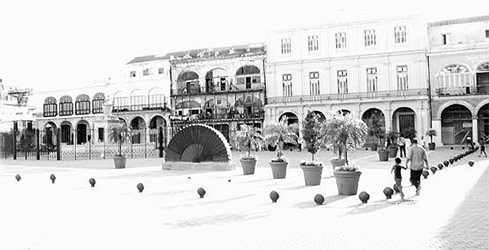ONE
As one
walks by the city of Havana, one senses a process of change of its
traditional appearance, in its best known zones - the Historic Center
and the great Republican area - as well as in certain neighborhoods
and residential areas built in the very beginning of the second half
of the 20th Century. The city changes day by day in front of our very
eyes, it transforms itself. The citizens place protective railings
on their balconies, or enclose with fences of steel wire the small
gardens at the entry of their houses to convert them into garages
or just to isolate themselves from the sidewalk and the street traffic.
Others build walls on the beautiful porches in order to get new space
(a room, a hall, a kitchen or a dining room) for those houses that
get smaller as the family grows larger.
There
are those who decide to set up a small shop to sell coffee, cakes,
biscuits, cold drinks, milkshakes or pizzas of various sorts in front
of their homes or in the common space in the apartment buildings,
and usually place an improvised wooden table on top of which they
put a blender, a big thermos flask, a display case, trays and hand
made signs with the offered products and their prices. Others advertise
some repair services — shoes, fans, watches — or special
services such as barbering, plumbing, masonry or jewelry without noticing
the consequences of this graphic paraphernalia for the ‘image’
or the culture of the city.
Over
the last years people, in an informal way and without hardly any control,
people have been transforming the fronts of their houses and buildings,
or re-shaping corners and empty lots through processes of free intervention
on the public spaces that the city had preserved since its foundation.
Urban laws, norms and regulations, devised to organize any kind of
expansion or transformation are continually being circumvented, not
only by ordinary citizens, but also, though to a lesser extent, by
state companies and ins-titutions. Thus, the city of Havana have started
to blur its architectural outline and features, making the image that
still characterizes it in the eyes of its own citizens and of lots
of visitors from all over the world fade away.
This
is not exclusive for Havana: it happens to the barrios of Bogota,
San Jose, Mexico City, São Paulo, Manila, Jakarta, Istanbul,
Alexandria, Port-of-Spain, Santo Domingo, Luanda, Harare, and hundreds
of other big and small metropolises in our regions of the southern
hemisphere. Since the so-called progress and development — to
some, the well-known ‘modernity’ — are still to
be introduced (from the outside) or to emerge (from the inside) of
our difficult, unstable and feeble economies, people face in their
own ways the challenge of the present and of the future, and to that
end they ‘make’ the decisions they estimate to be the
correct ones, they ‘organize’ their lives individually
and set out to ‘improve’ their material parcels, their
habitats, in a prodigious attempt to gain time — from time.
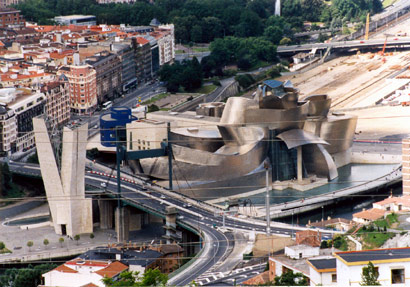 Bilbao
- PHOTO:
Ximena Narea
Bilbao
- PHOTO:
Ximena Narea
|
On the one hand, ads, colors, symbols and signs,
tents, umbrellas, light roofs, lights, bars, fencings of bricks, stone
or cement, trees, bushes, flowers, horns, television antennae and
lamps, are some of the elements with which the citizens of our ‘developing’
countries design their everyday environment, the one of their barrios
and by extension, that of their cities. Most of the time this takes
place with little creative power, although in some cases occasional
traits of humor and popular wisdom blossom and amuses us making us
feel a little bit more at home, entertained.
On the other hand, the exaggerated and uncontrolled
growth of the urban populations in each country in our regions, due
to the phenomenon of migration and its corresponding informal economy,
contributes to the generalization of a hardly interesting image —
sometimes chaotic, entangled and anarchic — of the city and
the milieu in which thousands and millions of people live. In those
urban spaces, however, a remarkable visual-formal counter-weight becomes
apparent in the more or less ‘attractive’ design of big
warehouses, stores and shopping centers, coffee shops, clubs and hotels
with the corresponding network of graphic information associated with
these buildings, plus a wide range of habitation, banking, judiciary,
educational, entrepreneurial and all sorts of beaurocratic facilities
whose architectural materialization obeys to a standardized ‘global’
typology. Added to the former, the paraphernalia of commercial, cultural
and political propaganda advertisements causes the visual culture
of our cities to be superior in impact, quantity and variety to that
of the role played by art institutions, whose purpose is the aesthetic
‘education’ and the shaping of a taste, a way of thinking
and a culture legitimized by the official histories of each community
and nation.
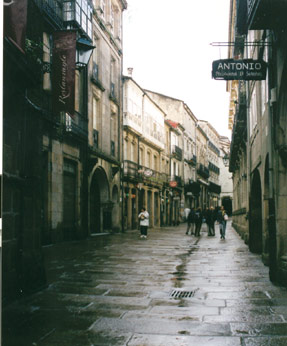 Santiago
de Compostella - PHOTO:
Ximena Narea
Santiago
de Compostella - PHOTO:
Ximena Narea |
At
first sight, it looks like a fight between a lion and a monkey,
since the total sum of museums, galleries, cultural centers
and some specialized institution is insufficient to counter
such a visual impact, because it represents a tiny percentage
in comparison with the omnipresence of all those other ‘institutions’
that today are necessary and essential, practically indispen-sable
elements of the urban mesh.
As a complement of this specific and variegated visual landscape
undergoing constant growth, one can hear musical groups on the
sidewalks, parks, gardens or squares. However, the majority
of those sounds don’t come from live music, but from cafeterias,
shops, bars, taxis and buses, which makes the urban environment
even more complex and crowded. Although this could seem like
something very characteristic for cities in the Caribbean region,
we can also find it on the ‘continent’: Lima, Panama
City, Caracas, São Paulo, Bogota, Bahia, Fortaleza, Managua.
For that reason, the everyday life in the open spaces of many
of our cities resembles a kind of carnival, a festival of images
and sounds, a spectacle not always subject to norms of organization
and design, which in the end alters our states of mind in a
silent, subtle and imperceptible way, our habits, our social
beha-vior, and our ways of ‘seeing the world’.
|
In Old Delhi, for example, one can inhale the
intense and penetrating smell of spices that immediately would make
one recognize the place one is walking on, added to the also unforgettable
amazement occasioned by the unrestricted access of cows on the public
streets. If we add the world’s only bird hospital to this, we
could shift from wonderment to delirium in an ins-tant. About the
smells, the same thing happens in some markets in the Golden Horn,
in Istanbul’s historic area, and in the harbor of Valparaiso,
where some of them mix with those produced by salts, birds and old
pieces of metal. In Addis Ababa, I remember a street in the beginning
of the 80’s christened by some foreigners to The Wall, not for
being a construction made with bricks, cement or steel: it was because
of the very strong and sharp and not so pleasant odor which literally
impeded traffic. One was forced to give up and take another route
in order to continue. Something similar occurs in the depressed alley,
popularly known as ‘El cartucho’ in down town Bogota,
although here one should add a touch of local violence never imagined
in the peaceful African city.
In the Casbah in Algiers, one of the fascinating
sites of the Islamic architecture and urbanism, it is not re-commended
to enter alone if one is a foreigner, given the real possibility of
getting lost and never being able to get out, or given the risk of
falling into the hands of local malefactors looking for an easy prey.
The same recommendation is made by the inhabitants of some barrios
in Rio de Janeiro, Medellin, Caracas (no way, pana, your friends will
tell you): all that belongs doubtlessly to the ‘image’
of the city.
Taking cabs and small buses in Santo Domingo,
Port of Spain or Fort de France is a unique experience in the Caribbean
due to the shock of the frantic music inside each vehicle, from which
it is only possible to recover a few minutes after having left the
car. In order to move from one place to another in Cairo, it is better
not to be in a hurry: more that 2 million taxis and urban buses traverse
the city day and night in the planet’s least signalized city,
and probably the noisiest one, where hardly 20 or 30 semaphores are
in working condition because of the fine dust from the nearby Sahara
desert. All this causes a generally accepted traffic chaos in which
every driver thinks he’s right.
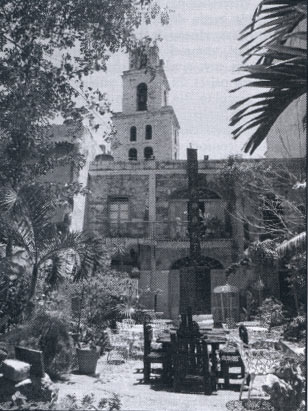 Patio
interior de un edificio en La Habana Vieja
Patio
interior de un edificio en La Habana Vieja
PHOTO:
Ximena Narea |
We live, then, in a state of environmental
alteration, sometimes of nice, ‘surreal’ or crazy,
other times, of more dramatic, confusing and exasperating
appearance. Both warn us that we are moving within a complex
and difficult universe of violent contrasts that are dynamic
in more than one sense, dominated by hidden forces of order
and, sometimes, of disorder. We have gotten ‘accustomed’
to both. It is the world where we are born and educated, and
it is also a source of a vast and wealthy cultural diversity
that we feel proud of in spite of the extreme economic conditions
in which it develops. Those urban cultures have given countless
signs of vitality, imagination, talent and energy, not always
acknowledged in other instances and scenes of the world, although
in the last decades an approaching to them has been taking
place. The bridges raised to and from our regions seem today
strong enough as to share that information, know-ledge and
emotions in both senses, and thus give birth to a new era
of universal understanding after hundreds of years of distance.
Good fortune is never too late, says one of our popular proverbs.
TWO
In Berlin, streets could be considered
perfect for tra-veling in vehicles: there are signalized footpaths,
cro-ssings, turns and circulations, and signs where the routes
to be followed are specified, as well as faraway and nearby
towns, important places, parking lots, dangerous passages
and obstacles. The sidewalks show clearly where the pedestrians
should walk and where the bicycles should transit, what places
are for functionally impaired persons, and where to find trash
bins or public phones. Each sign and symbol has been designed
by professionals who treat each and every one of these messages
rigorously, whether that might be for commercial establishments,
diners, coffee shops or places where one can listen to music.
Nothing is left to chance, spontaneity or improvisation.
|
In many other cities of Central and Eastern
Europe the same happens: their citizens move every day within an order
determined by laws and regulations, whose graphic expression in formal
terms corresponds to a universe of high economic development. The
commercial advertisement signs reach astonishing dimensions, in some
cases occupying the facades of buildings of many stories and are efficiently
adapted to the codes of today’s graphic design: good photographies,
efficient typography, simplicity and precision in the selected images,
and high resolution prints. The same thing happens with posters and
mural ads for culture and entertainment, though these are of smaller
dimensions.
In these European cities, there are norms forbidding
landlords and shop owners to surpass a certain level of decibel if
they wish to listen to music or produce any kind of sound. No one
is allowed to spontaneously transform the windows, doors and balconies
of their homes, or to intervene in the public space as they please.
On the other hand, squares, parks and green areas in the city show
countless sculptures, paintings, objects, interventions and urban
paraphernalia of remarkable beauty. The same happens with the show
windows in shops, bus and train stations and airports, whose level
of design surpasses that of other countries. The public space in which
millions of citizens circulate every day, from or towards their homes,
it is designed with the aim to guarantee their safety, comfort and
an efficient level of information.
Helsinki, Oslo, Stockholm, Copenhagen or Rejkavik,
are notorious examples of this integral environmental design. To some
this can seem exaggerated and dull, since not even the smallest architectonic
or urban detail escapes from the municipal authorities. Nothing is
‘put out of place,’ or dislocated in this little perhaps
radically cold and rational environment. The ‘perfection’
of this visual universe is such that, by contrast, many citizens in
these latitudes travel to our regions to enjoy ‘the other,’
that which could be called ‘the real-marvelous’ (a literary
way of pondering the juxtaposition and superimposition of codes and
visual signs, music, noise, chaos and poverty) that inhabits our cities
and regions, whose materialization, with local variations characteristic
of the context, can be found in Havana.
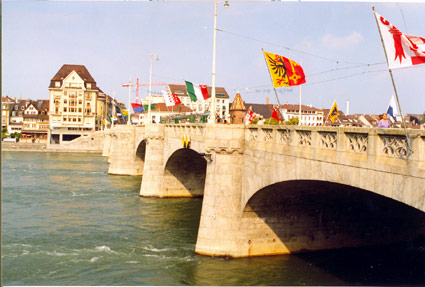 Basilea
/ PHOTO:
Ximena Narea
Basilea
/ PHOTO:
Ximena Narea
|
THREE
The question does not lie in elucidating what
form of inhabiting and living together is the best or the most pleasant,
because they respond to different socio-economic formations: something
that is so tangible and evident that we sometimes do not perceive
in its true dimension. Each one of these forms expresses the world
that created and upholds them. It is risky to affirm on which side
‘happiness’ or ‘life’ is. The millions of
inhabitants inserted in these urban dynamics have gotten used, to
live in and from them although temporally or even definitively, they
move to others. That happens frequently to professionals at various
levels and ranks, and even to artists. It seems that the ‘reason’
for this lies nowhere but in the complex rea-lity they face —
which is different in Europe, the United States, Africa, the Middle
East, Asia, Latin America and the Caribbean.
Facing it from the perspective of differences
might prove to be the most sensible way to help ourselves to understand
more objectively the art produced today in each one of our regions,
be it in areas consi-dered as ‘developing’ or in highly
industrialized countries that have started a slow process of ethnocultural
transformation as the result of visible migrations and the necessary
exchanges of this globalized universe.
FOUR
That world of images (and sounds, noises, odors,
street actions...) that populate the geography of our cities, inexorably
conditions the tastes, nourishes the imagination and molds the sensibilities.
From it, our artists extract many of the signs and referents to cons-truct
their works, since most of their concepts and ideas share the same
source. Those of us who are not artists (Joseph Beuys would not approve
of such statement), that silent majority of citizens is also conditioned
by a way of ‘seeing,’ not only the world that surrounds
us, but also other worlds beyond our noses. To this we could add —
and it would make this story longer — the fashion that every
citizen adopts according to his preferences and means, as well as
many other factors (cars, trucks and buses circulating by day and
by night, the illumination of streets and public places) until we
achieve an exhaustive analysis, but here I limit myself to those belonging
or being associated to the visual, being re-appropriated as signs
and symbols by the artists from within their territories, in may cases
with the support of curators and institutions, specially when it has
to do with cultural events, of big or small impact.
Our cities, towns , villages and hamlets generate
a kind of visual culture in some ways different to the one we could
find in other urban settings where any ambulant activity hardly exists,
informal economy, illegal appropriations of public spaces, abundant
ruins, settlements illegally constructed with poor materials, and
undiscriminated advertisement. It is about, once again, a contextual
problem, a problem of daily influences of that urban culture on the
citizens, which has represented a never ending source for our artists
during the last years, as it can be confirmed in Brazil, Mexico, Chile,
Puerto Rico, Belize, Cuba, Colombia, South Africa, Angola, Nigeria,
Thailand, Indonesia, the Phili-ppines and China.
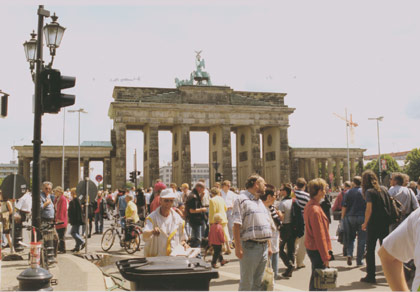 Berlín
/ PHOTO:
Ximena Narea
Berlín
/ PHOTO:
Ximena Narea
|
It
is no longer only ‘the big narratives’ that are the cause
of many valuable works in our regions (from history, social movements,
politics to ideologies, gender and race issues). Now, even certain
areas of eve-ryday life, of the intricate mesh of messages upon which
we stumble every day in the streets, of the quotidian challenges that
the old and new economic structures submit us to, and of our share
of dreams and aspirations. We face an objective and subliminal bombardment
of visual codes — far superior in quantity to that attributed
to certain electronic communication media — which become visible
to the eyes and sensibilities of our artists.
Hence the more active participation of our creators on and upon the
urban environment, independently from their scale and signification,
since the cities have become the largest and most exciting galleries
for the circulation of works, and a space for the confrontation and
reflection upon their fortune and their destiny. Many wish to contribute
from their tiniest parcel to shed light (be it from parody, criticism
or adulation) of those ongoing transformations taking place in buil-ding
blocks, parks, streets and squares.
Art
seems thus engaged in the return to one of its places of origin, to
the recovering of the role played by the community and the city in
human history, long before it was subdivided into functions and classes.
It is a trip to the seed, postponed by a span of centuries. The eternal
return.
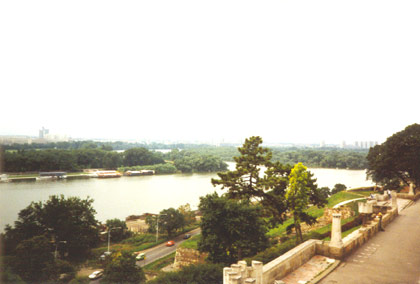
Belgrad
/ PHOTO:
Ximena Narea
|
FIVE
There are as many urban cultures as specific
realities in each city, country and region. I have attempted here
to underline those where perhaps more ample margins exist for disordered,
non-regulated interventions; that is, where non-professionals participate,
even when they do not produce a sufficient amount of visual and non-visual
images. This could be called urban popular culture, in its wider sense.
But it is hardly ever mentioned, since it is not produced from within
the territories legitimated and sanctified by art historiography and
criticism: many of its creators are not sufficiently known, their
‘works’ escape the traditional analysis and studies in
spite of the massive volume they occupy within the physical space
where they are produced and of their undeniable influence on everyday
life.
From their own territories, and perhaps from
other more distant ones, various ar-tists reflect upon them from a
critical pers-pective with the aim of calling the attention of the
public and contribute to their improvement, whereas other exalt some
of its traits as an important factor in the identity of a city, or
of a small or big urban conglomerate. And an event such as the Biennial
of Havana puts them in circulation within an open system of artistic
proposals and exhibits, integrates them in its structure and organization,
and shows them to a public, perhaps captive of the splendid and effective
spider webs of a post modernity that has not done enough justice to
them, still busy privileging other expressions closer to the market,
to the controversial dictates of an international contemporary curatorship
and to the ‘tyranny of the museums.’ However, they continue
to be fundamental and profound ingredients of our identity at the
environmental, cultural and social levels, and the Biennial of Havana
doesn’t refrain from insisting on any of the aspects that could
shed light on our lives and destinies, even at the risk of repeating
ourselves.
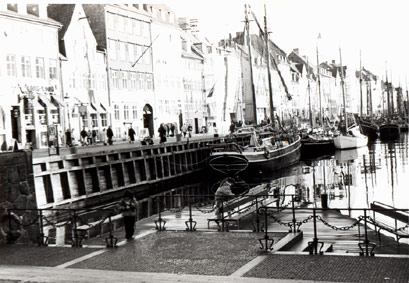 Copenhague
/ PHOTO:
Ximena Narea
Copenhague
/ PHOTO:
Ximena Narea
|
We are thus still engaged in trying to identify our
various identities and faces, because they are many, perhaps too many.
While many think they know us thanks to the achievements
of certain humanistic disciplines and sciences, we discover with preoccupation
and enthusiasm those elements that have been poorly visible to our
own eyes and hearts.
There are those who think they know everything, or
almost everything, about themselves: happy them.
We think that we do not know enough about this entangled
visual, cultural mesh underlying our cities except for ‘that’
shown every day by the television and the newspapers.
It is about this so exciting and polemic phenomenon
that we pronounce ourselves in an international event that must aspire
to serve to the exchange of ideas and human beings in spite of the
serious economic strains we are going through.
(Note by the author: this text is a barely modified version of the
original, published in the General Catalogue of the ninth edition
of the Biennial of Havana, in March-April 2006.)


